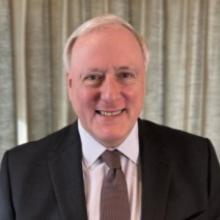
Andrew J. Whittle is the Edmund K. Turner Professor of Civil and Environmental Engineering at MIT. His research deals with the development of constitutive models for soil behavior and their application in predicting the performance of foundations and underground construction projects. He has also carried out extensive research on wireless sensor networks for monitoring underground infrastructure notably in the detection and localization of leaks in water pipe networks and was Chief Scientific Advisor for Visenti Pte. (now a Xylem Brand company). He is a licensed professional engineer (PE, New York State and P.Eng., Alberta) and an active consultant who has worked on more than 30 major onshore and offshore construction projects. He was an expert involved in the investigations into the collapse of the Nicoll Highway in Singapore and has also served on review panels for hurricane protection systems in New Orleans (NRC), ‘stem-to-stern’ safety of the Big Dig tunnels (Boston), and causes of construction delays for the XRL project (Hong Kong). He served on the Board of Directors for the Massachusetts Department of Transportation, 2009-2015.
Dr Whittle is a Co-Editor of the International Journal of Numerical and Analytical Methods in Geomechanics (since 1999). He has published more than 260 papers in refereed journals and conferences, and received several awards for his research work and papers from the American Society of Civil Engineers, is an Honorary Professor at Tsinghua University (2019) and was elected to the US National Academy of Engineering in 2010. He was a CGS Cross-Canada Lecturer (2007) and the ASCE-GI Cross-USA lecturer (2018). He has been invited to present the 61st ASCE Karl Terzaghi Lecture (2024).
This lecture will summarize recent progress that addresses three different topics associated with modeling scale effects in soils: The first concerns the classic problem of physical scaling of foundation bearing resistance on sands: Here, advances in elasto-plastic modeling of compression and shear properties (using the MIT-S1 model) can explain the effects of relative density and foundation length scale on the bearing mechanisms, while further work is needed to predict shear banding at large deformations. The second considers time scaling of clay deformations: There are many (often contradictory) observations of the viscous properties of sedimentary clays, and a long-standing dilemma regarding the coupling of creep and consolidation processes. We have developed a new physically-based evolution law that attributes the macroscopic viscoplastic strain rate to an internal variable associated with the prior strain rate history. By varying the rate-sensitivity parameter the proposed model (MIT-SR) provides a unified framework that can describe a wide range of observed time-effects in 1-D compression and shear behavior. The model has been applied to interpret long-term deformations in several projects. The third part describes recent research on multi-scale, bottom-up modeling of clay behavior. We have developed a meso-scale model of clay aggregate formation by up-scaling from simulations of interactions between pairs of clay platelets solvated in water. The lecture will summarize recent results on engineering properties of Illite aggregates showing how plastic deformations can be related to compression of the aggregates, while non-linear, hysteretic and inelastic behavior emerge in quasi-static shearing of aggregates.
